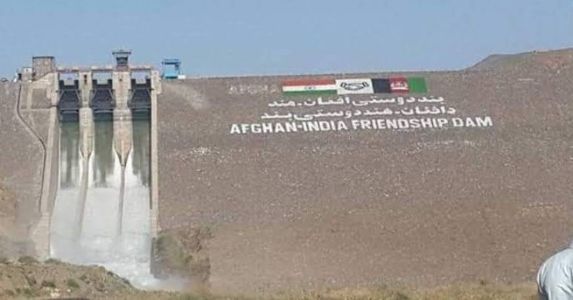SOURCE: AFI


The escalating tensions between India and Pakistan, particularly following the April 22, 2025, Pahalgam terrorist attack that killed 26 tourists, have underscored the need for India to leverage non-military tools to counter Pakistan’s sponsorship of cross-border terrorism. One potent strategy is to fund the construction of dams on Afghan rivers, such as the Kabul and Kunar, which flow into Pakistan’s Indus River system.
By supporting Afghanistan’s hydropower and irrigation projects, India can reduce water flows to Pakistan, exerting economic pressure on its agriculture-dependent economy while strengthening ties with Kabul. This approach, exemplified by India’s funding of the Shahtoot Dam, aligns with New Delhi’s broader geopolitical strategy to isolate Pakistan and promote regional stability, serving as a precursor to any kinetic actions.
Pakistan’s economy heavily relies on the Indus River system, which supports 80% of its irrigated agriculture, contributing 25% to its GDP and sustaining 70% of its rural population. The Kabul River, a key tributary originating in Afghanistan’s Hindu Kush mountains, flows through Kabul, Jalalabad, and into Pakistan’s Khyber Pakhtunkhwa province, where it joins the Indus. The Kunar River, another critical tributary, originates in Pakistan as the Chitral River, flows into Afghanistan, and returns to Pakistan, making it a shared resource. Any reduction in these rivers’ flows, particularly during the dry season, could disrupt Pakistan’s crop yields, exacerbate food insecurity, and strain its already fragile economy, with foreign reserves at $10.5 billion compared to India’s $678 billion.
India’s suspension of the Indus Waters Treaty (IWT) on April 24, 2025, following the Pahalgam attack, marked a significant escalation, allowing New Delhi to build dams on the western rivers (Indus, Jhelum, Chenab) without notifying Pakistan. However, India’s existing infrastructure limits its ability to immediately choke these flows, with projects like the Kishanganga and Ratle dams requiring years to fully impact Pakistan. Funding dams in Afghanistan offers a complementary strategy, enabling India to indirectly influence Pakistan’s water security while avoiding the immediate risks of direct military confrontation.
India has already demonstrated its commitment to Afghan water infrastructure, funding projects that have raised concerns in Pakistan. The $300 million Shahtoot Dam, agreed upon in November 2020, is under construction on a Kabul River tributary in Chahar Asiab, near Kabul. It will store 146 million cubic meters of water, irrigate 4,000 hectares, and provide drinking water to 2 million Kabul residents. Pakistani media, citing a 16-17% potential drop in Kabul River flows, have expressed alarm, particularly in Khyber Pakhtunkhwa’s fertile districts of Peshawar, Nowshera, and Charsadda. The $290 million Salma Dam (Afghan-India Friendship Dam), completed in 2016 in Herat, irrigates 75,000 hectares and generates 42 MW of electricity, reducing Afghanistan’s reliance on imported power but impacting downstream flows into Iran.
Why Fund Afghan Dams?
- Economic Pressure on Pakistan: Pakistan’s agriculture, particularly in Punjab and Sindh, depends on the Indus system, with the Kabul River contributing up to 17% of its water. Dams like Shahtoot could reduce flows by 16-17%, impacting crops like rice and wheat, which are vital for exports and food security. During the dry season, when water is scarce, even modest reductions could exacerbate Pakistan’s groundwater depletion and urban water shortages, as seen in Karachi’s reliance on private tankers.
- Strengthening India-Afghanistan Ties: India has invested over $3 billion in Afghan infrastructure, including roads, hospitals, and the Afghan Parliament. Funding dams reinforces this partnership, countering Pakistan’s influence in Afghanistan, particularly under the Taliban regime. The Taliban has prioritized water projects to address climate change and population growth, and India’s technical expertise, as seen in its 2022 mission to assess projects, positions it as a reliable partner.
- Diplomatic Leverage: By supporting Afghan dams, India can rally international support for its stance against Pakistan’s terrorism sponsorship. The US, a key ally, has condemned the Pahalgam attack, and India’s briefings to 100 diplomatic missions post-attack demonstrate its ability to shape global narratives. Highlighting Pakistan’s objections to Afghan development projects as self-serving could isolate Islamabad further.
- Avoiding Direct Escalation: Unlike military strikes, funding Afghan dams is a non-kinetic tool that avoids immediate nuclear risks. Pakistan’s threat to treat water blockages as an “act of war” is tempered by its economic constraints and reliance on allies like China, which may hesitate to escalate tensions given its own economic challenges. This approach allows India to impose costs gradually, creating a “domino effect” on Pakistan’s economy.
India should adopt a multi-pronged approach to fund and support Afghan dam projects:
- Target Key Rivers: Focus on the Kabul and Kunar Rivers, where dams can significantly impact Pakistan. Afghanistan plans 12 hydropower projects on the Kabul River, generating 1,177 MW and storing 4.7 million acre-feet (MAF) of water. India should fund feasibility studies and construction for projects like the proposed dams on the Kunar River, which a Chinese firm expressed interest in building in 2024. Collaborating with China, as suggested in a 2015 trilateral meeting, could mitigate Pakistan’s objections while advancing India’s interests.
- Increase Financial Commitment: Allocate $500 million to $1 billion over the next decade for dam projects, building on the $80 million Phase-IV High Impact Community Development Programme announced in 2020. This funding could support 3-5 medium-sized dams, each storing 100-200 million cubic meters, amplifying the Shahtoot model.
- Technical and Diplomatic Support: Deploy Indian engineers and hydrologists to Afghanistan, as done in 2022, to accelerate project timelines. Diplomatically, India should counter Pakistan’s push for a Kabul River water-sharing treaty, which Afghanistan has resisted, by emphasizing Kabul’s sovereign right to develop its resources.
- Engage the Taliban: Despite the Taliban’s takeover in 2021, India has maintained contact for project completion. Offering economic incentives, such as trade concessions via Chabahar port, could secure Taliban cooperation, ensuring projects proceed despite Pakistan’s objections.
NOTE: AFI is a proud outsourced content creator partner of IDRW.ORG. All content created by AFI is the sole property of AFI and is protected by copyright. AFI takes copyright infringement seriously and will pursue all legal options available to protect its content.